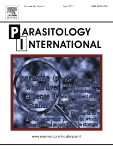Molecular characterization of calmodulin from Sarcoptes scabiei
Ran He, Nengxing Shen,HaiLin,XiaobinGu,WeiminLai, Xuerong Peng, Guangyou Yang

Scabies, caused by the mite Sarcoptes scabiei, is a highly contagious parasitic disease that affects millions of people and other mammals worldwide. Calmodulin (CaM) is an important calcium sensor that participates in various critical physiological processes. In this study, the CaM of Sarcoptes scabiei (SsCaM) was cloned and expressed, and sequence analyses were performed using bioinformatics tools. Recombinant SsCaM (rSsCaM) was used to detect antigenicity using immunoblotting assays, and the serodiagnostic potential of rSsCaM was assessed by indirect enzyme-linked immuno-sorbent assay (ELISA). The calcium binding properties and 8-anilinonaphthalene-1-sulfonic acid (ANS) fluorescence of rSsCaM were also measured. The results indicated that SsCaM contains a 450-bp open reading frame that encodes for a polypeptide with 149 amino acids, and SsCaM was expressed as a soluble protein. Multiple sequence alignment and phylogenetic analyses indicated similarity and genetic distance between SsCaM and other species. The calcium binding properties and ANS fluorescence of rSsCaM indicated typical calcium binding characteristics. Immunolocalizaton assay showed that SsCaM was widespread inS. scabiei. SsCaM-based ELISA exhibited a sensitivity of 87.5% (28/32) and a specificity of 22.5% (9/40) for detecting anti-CaM antibodies in the sera of naturally infected rabbits. The findings of this study provide a comprehensive molecular characterization of SsCaM and suggest that rSsCaM is inappropriate for detecing S. scabiei. The results may also contribute to future studies on the molecular characteristics of the CaM of parasites.
Copyright © 2016. Published by Elsevier B.V.
Parasitology International,2017,66:1-6Read full text:
https://www.researchgate.net/publication/309889992_Molecular_characterization_of_calmodulin_from_Sarcoptes_scabiei